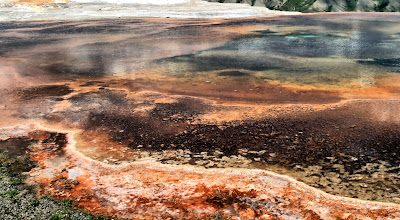 |
| An image of the Upper Geyser Basin region in Yellowstone National Park in Wyoming, USA. As the Sun heats up, much of the Earth will come to resemble this landscape [Credit: Jack O’Malley-James] |
The main driver for these changes will be the Sun. As it ages over the next few billion years, the Sun will remain stable but become steadily more luminous, increasing the intensity of its heat felt on Earth and warming the planet to such an extent that the oceans evaporate. In his new work, O’Malley James has created a computer model to simulate these extremely long-range temperature forecasts and has used the results to predict the timeline of future extinctions.
Within the next billion years, increased evaporation rates and chemical reactions with rainwater will draw more and more carbon dioxide from the Earth’s atmosphere. The falling levels of CO2 will lead to the disappearance of plants and animals and our home planet will become a world of microbes. At the same time the Earth will be depleted of oxygen and will be drying out as the rising temperatures lead to the evaporation of the oceans. A billion years after that the oceans will have gone completely.
"The far-future Earth will be very hostile to life by this point", said O'Malley-James. "All living things require liquid water, so any remaining life will be restricted to pockets of liquid water, perhaps at cooler, higher altitudes or in caves or underground". This life will need to cope with many extremes like high temperatures and intense ultraviolet radiation and only a few microbial species known on Earth today could cope with this.
The new model not only tells us a lot about our own planet's future, but it can also help us to recognise other inhabited planets that may be approaching the end of their habitable lifetimes.
O’Malley-James adds "When we think about what to look for in the search for life beyond Earth our thoughts are largely constrained by life as we know it today, which leaves behind telltale fingerprints in our atmosphere like oxygen and ozone. Life in the Earth's far future will be very different to this, which means, to detect life like this on other planets we need to search for a whole new set of clues".
"We have now simulated a dying biosphere composed of populations of the species that are most likely to survive to determine what types of gases they would release to the atmosphere. By the point at which all life disappears from the planet, we're left with a nitrogen:carbon-dioxide atmosphere with methane being the only sign of active life".


No comments:
Post a Comment